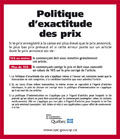Merchants have 2 ways to go about pricing: tag each item individually or display an item’s price on its shelf.
Merchants have different rules to follow whether they indicate the price on each item or on the item’s shelf. In the latter case, merchants must abide by the Price Accuracy Policy.
Prices shown on the shelves
The Price Accuracy Policy allows customers to be compensated in case of a pricing error at the register. If the price of the article you are buying is higher at the register than what was shown on the shelf, the merchant must:
- give you the item for free if the item costs less than $10;
- sell you the item at the shelf price, minus $10, if the item costs more than $10.
This compensation policy does not apply to products without bar codes, such as fruits or vegetables that are sold loose.
The Price Accuracy Policy also does not apply, for example, to the following products:
- cow’s milk;
- tobacco products;
- beer, wine, and spirits sold in grocery or convenience stores, if applying the policy brought the product’s price below the minimum selling price provided by the law;
- prescription drugs.
Prices shown on individual items
If the merchant decides to individually tag each article, they don’t have to abide by the Price Accuracy Policy. However, they must sell items at the labelled price, never at a higher price. For example, an item tagged at $5 must be sold at that price, even if the register shows $7.
What if a single item shows two different prices? The lower price prevails.
Always check the receipt before leaving the store
To avoid having to go back to the store to recover a few dollars, make sure you always check the receipt before leaving the store. However, if you only notice an error when you’re back home, you can go back to the store. It’s never too late to assert your rights.
The section Price indicated in the store provides all the information about the pricing of items, the display of prices, and the Price Accuracy Policy.
Merchants must display the selling price of every item sold in their store.
To be exempt from this obligation, merchants must, among other things, display an item’s price on its shelf (the price must be displayed close to the item) and use an optical reader to scan purchased items.
Price display exemptions
The law provides exemptions regarding the display of prices. Merchants must clearly and legibly display prices close to items that are exempt from the above-mentioned regulation. For example:
- Unpackaged items with a price calculated according to a unit of measure (for example, fruit sold by the kilo);
- Foods that are not packaged before being sold (for example, a $2 melon);
- Frozen foods;
- Items sold for $0.60 or less;
- Items sold in a vending machine.
The page Labelling and price indication rules presents a complete list of items that are exempt from the regulation.
Denunciation
If a merchant does not display prices or displays erroneous prices, you can file a complaint with the Office de la protection du consommateur. The Contact us page provides the ways to reach us.
Last update : March 4, 2025
Was the information on this page useful to you?
The information contained on this page is presented in simple terms to make it easier to understand. It does not replace the texts of the laws and regulations.











Thank you! Your comment was submitted successfully.